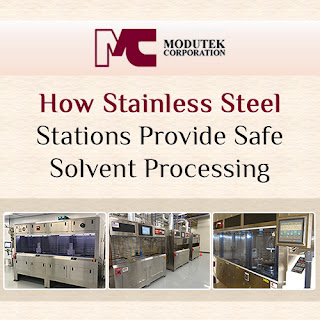Solvents used in semiconductor manufacturing can remove and organic contaminants from silicon wafers in preparation for further processing steps.
Acetone, isopropyl alcohol (IPA) and ethylene diproxitol (EDP) are solvents commonly used to clean wafers, remove photoresist and in pattern transfers for the creation of microscopic structures on the wafer.
But since these solvents are also inflammable, they require special safety measures to reduce the risk of fire and explosion, and they have to be disposed of safely. Stainless steel wet benches incorporating stainless steel processing tanks are designed with features that provide safe processing of solvents.
Safe operation of stainless-steel solvent stations has to include the following safety measures:
· Fire suppression – Measures can include electrical design limiting the potential energy of sparks so they can’t ignite solvents and designing equipment to Class 1, Division 2 specifications
· Fire fighting – It has to be able to extinguish fires. For inflammable liquids such as solvents, gas-type fire systems such as those using carbon dioxide are needed.
· Protection against exposure – Many solvents are harmful when workers are exposed to them over extended periods, either through direct contact or through breathing the fumes. A complete enclosure of the solvent processing tanks along with effective exhausts limits the amount of solvent to which workers can be exposed.
· Protection against leaks – A complete enclosure of the solvent processing tanks should also have a leak detection feature.
· Safe disposal – Disposal of used solvents has to be carried out safely and according to environmental regulations. Disposal can be on site, if the facility has the corresponding capability, or the waste can be stored in a carboy for pick-up by a specialized disposal company.
Modutek’s stainless steel stations are made of 304 stainless steel and are available in fully automatic, semi-automatic, or manual versions. Dry to dry and fume hood designs are possible, and the stations feature casters and leg levelers.
Modutek’s semi-automated and fully automated wet benches have a built-in SolidWorks simulation software that calculates the process flow characteristics, and all design, assembly, and testing is carried out in-house. As a leading wet bench manufacturer, Modutek works closely with customers to design and customize equipment to meet each client’s requirements.
For more details read the complete article, “How Stainless-Steel Stations Provide Safe Solvent Processing”. If you have questions after reading the article or would like to set up a free consultation to discuss your particular needs, contact Modutek via email Sales@Modutek.com or by calling 866-803-1533.



